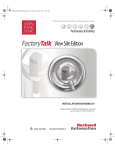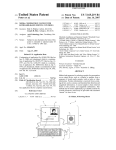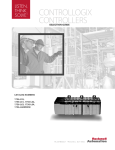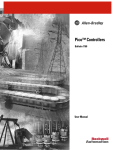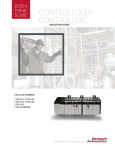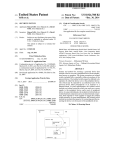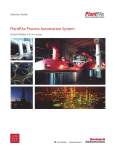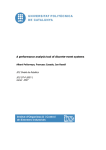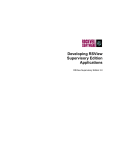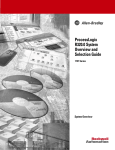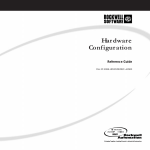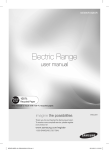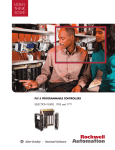Download “1::
Transcript
US007530113B2 (12) Ulllted States Patent (10) Patent N0.: Braun (54) US 7,530,113 B2 (45) Date of Patent: May 5, 2009 SECURITY SYSTEM AND METHOD FOR AN 2004/0259111 A1 * 12/2004 Marlowe et a1. ............. .. 435/6 INDUSTRIAL AUTOMATION SYSTEM 2004/0260518 A1 * 12/2004 PolZ et a1. ....... .. 2004/0260954 A1* 12/2004 Morse ...................... .. 713/202 Inventor; Scott D, Braun, Fredonjaa 702/188 2005/0021158 A1 * 1/2005 De Meyer et al. ........... .. 700/23 2005/0021839 A1* 1/2005 Russell et a1. ............. .. 709/238 (73) Assignee: Rockwell Automation Technologies, Inc., May?eld Heights, OH (US) (*) Notice: (Continued) Subject to any disclaimer, the term of this patent is extended or adjusted under 35 U.S.C. 154(1)) by 712 days. FOREIGN PATENT DOCUMENTS 1221160 A (21) Appl. N0.: 10/902,453 (Continued) (22) Filed: Jul. 29, 2004 (65) Pnor Pubhcatlon Data US 2006/0026672 A1 Feb. 2, 2006 (51) Int, Cl, - OTHER PUBLICATIONS - - Zecevic, Goran. “Web based interface to SCADA system”, Interna tional Conference on Power System Technology, Aug. 1998* Allen-Bradley User Manual entitled “1336 ImpactTM Adjustable Fre quency AC Drive; 0.37-597 kW (0.5-800 HP) Version 1.XX-4.Xx”; (date unknown); 50-page (as photocopied) brochure; Product of G06F 7/04 (200601) H0“ 9/32 Rockwell Automation. (200601) U s C] I , 726/28' 726/4- 726/17- , - PI‘. -page as p O 0001) (Continued) Primary ExamineriMichael J Simitoski Field of Classi?cation Search ................. .. 726/28, 726/4, 17; 713/168, 172, 183E186; 709/224i225; _ ggaféggeykufziigsii 0r plrmipletcher Yoder Law; ' 709/9’ 237’ 83 (57) See appl1cat10n ?le for complete search h1story. (56) - Rockwell Automation‘ 713/186; 709/224; 709/225; 700/9; 7070633873; _ I ied) brochure; Publication 1789-UM001B-EN-P; Product of 713/168; 713/172; 713/183; 713/184; 713/185; (58) I gilinieéidléefslfiriléansu?591E? 23%??? 5 C°n<tr°11irl1789' 3 (52) 6/1999 ABSTRACT References Cited An industrial automation system comprises a security access Us PATENT DOCUMENTS device, an industrial automation device, a user interface, and a security interface. The user interface is con?gured to pro 6,636,620 B1 10/2003 HOShiIlO vide a user With access to data stored inside the industrial 2003/0030542 A1 2/2003 Von Hoffmann * E0111“ et :11‘ 2003/0200008 A1,, 10/2003 wifsililet ' 2003/0231l00 A1 12/2003 Chun """"""""""" " authorization for the user to access the data stored inside the 2004/0044420 A1 3/2004 Dingi et a1‘ 2004/0162996 A1* 8/2004 Wallace et al. ............ .. 713/201 2004/0236954 A1 automation device. The security interface is con?gured to receive information from the access device and, based on the information received from the access device, to provide 340/5 53 700/2'36 industrial automation device using the user interface. 11/2004 Vogt et a1. 81 Claims, 8 Drawing Sheets MGMT 122 ENG'G 14 WORKSTATION / \ l" I m OPERATOR 126 " WORKSTATION J ‘4 WORKSTATION / x \ l" 12a OTHER "2 I 125 1i WORKSTATION J 1/1 I 2 I “1:: INFORMATION SERVER 102 102 MOTO\R DRIVE MOTC; DRIVE 12 10s 1'14 :MI 12 (111% J 11211110 I \ 112 | 10 AUTOMZRI‘O’N 14 CONTROLLER )1 CONTROLLER J T112111; 1J2 I \ 112 I‘ 112 “(H / AUTJIATION I SECURITY INTERFACE l I 112 12 J 11: 1°6\ ACTUATOR I ’ I 111 SENSOR 12 I I \ 112 I ")6 IIO MODULE J SECURITY INTERFACE 12 12 I10 MODULE J SECURITY INTERFACE I I 112 12 / SECURITV INTERFACE \ I 112 US 7,530,113 B2 Page 2 “Securing Your Automation Ethernet Network”; (Jul. 6, 2001); US. PATENT DOCUMENTS 2005/0155043 A1* 2005/0229004 A1* 2006/0143469 A1 7/2005 10/2005 SchulZ et al. ............. .. 719/328 Callaghan ................. .. 713/185 6/2006 Schmidt et a1. CN CN CN EP 12/2002 1465496 A 1485746 A 1306816 A2 l/2004 3/2004 5/2003 1443343 A Eclipse Services. “Rockwell Software Products”; l-page document; [obtained from http://www.software.rockwell.com/navigation/products/indeX. FOREIGN PATENT DOCUMENTS 1387159 A 14-page document; Automation Business Network Certi?cation Ser vices; Schneider Automation Inc.; © 2001 Schneider Automation cfm?print:1]; [page last updated: Jun. 10, 2004]; © 2004 Rockwell Automation. 9/2003 “RSAutomation Desktop (An integrated control system design envi ronment)”; 2-page document; [obtained from http://www.software. rockwell.com/rsautomationdesktop/?print:1]; [page last updated: Jun. 10, 2004]; © 2004 Rockwell Automation. OTHER PUBLICATIONS US. Department of Homeland Security “Information Analysis and Infrastructure Protection”; 2-page document; [obtained from http:// www.ciao.gov/industry/indexhtml]; [page last updated: Feb. 3, 2004]. Allen-Bradley “Getting Results Manual” (DriveEXplorerTM, Version “RSLogiX (Programming for Allen-Bradley PLC-5, SLC 500, MicroLogix, and Logix5 000families)”; 2-page document; [obtained from http://www.software.rockwell.com/rslogiX/?print:1]; [page last updated: Jun. 10, 2004]; © 2004 Rockwell Automation. “RSLogiX Emulate (Debugging Your Logic Has Never Been Easier)”; l-page document; [obtained from http://www.software. rockwell.com/rslogiXemulate/?print:1]; [page last updated: Jun. 10, 2.02); (Mar. 2001); 34-page (as photocopied) brochure; Publication 2004]; © 2004 Rockwell Automation. 9306-GR001B-EN-E; © 2000 Allen-Bradley Company, Inc.; Prod “RSNetWorX (A Powerful Con?guration and Diagnostics Tool for ControlNet, DeviceNet, and EtherNet/IP Users)”; 2-page document; [obtained from http://www.software.rockwell.com/rsnetworX/? uct of Rockwell Automation. “Jump Onboard C-Manufacturing”; 4-page document; [obtained from http://www.ab.com/abj ournal/april2002/features/ jumpionboard/indexhtml]; [page last updated: Jan. 29, 2004]; A-B Journal Online: Apr. 2002. “Rockwell Software Products with Factory Talk Components” and “Web-Based Manufacturing Portals”; 2-page document (published prior to ?ling date). Rockwell Software User’s Guide entitled “RSView Supervisory Edi tionTM”; (Dec. 2003); 152-page (as photocopied) brochure; Doc ID VIEWSE-UM003C-EN-E; © 2003 Rockwell Software Inc.; Product of Rockwell Automation. print:1]; [page last updated: Jun. 10, 2004]; © 2004 Rockwell Auto mation. “RSTestStand (Test Your Control System O?-lineiOut ofthe Critical Path of Start-up)”; 2-page document; [obtained from http://www. software.rockwell.com/rsteststand?print:1]; [page last updated: Jun. 10, 2004]; © 2004 Rockwell Automation. “RSTestStand Enterprise (InteractivelyDesign and Test Your Control System)”; l-page document; [obtained from http://www.software. rockwell.com/rsteststandenterprise/?print:1]; [page last updated: Jun. 10, 2004]; © 2004 Rockwell Automation. Stackhouse et al.; “Siemens Security and Safety White Paper” (Apr. “RSView Studio (Development Environment for RS Wei/v Enterprise 2003); 21-page document. Series)”; l-page document; [obtained from http://www.software. rockwell.com/rsviewstudio/?print:1]; [page last updated: Jun. 10, “PLC-5®A.I. SeriesTM Software Reference”; (Jun. 1997); 41 pages; Product of Rockwell Software. 2004]; © 2004 Rockwell Automation. “Integrated Architecture”; (Oct. 2003); 42-page (as photocopied) “Arena (Forward J/lsibilityfor Your BusinessTM)”; 2-page document; brochure; Publication IA-BR002B-EN-P; © 2003 Rockwell Auto mation Inc.; Product of Rockwell Automation. [obtained from http://www. software.rockwell .com/arenasimulation/ ?print:1]; [page last updated: Jun. 10, 2004]; © 2004 Rockwell Allen-Bradley User Manual entitled “DriveLogiX Controller”; (Oct. 2002); 172-page (as photocopied) brochure; Publication 20D “RSView Enterprise Series (RSJTleW Machine & Supervisory Edi UM002A-EN-P; © 2002 Rockwell International Corporation; Prod uct of Rockwell Automation. Automation. tions)”; 2-page document; [obtained from http://www.software. rockwell.com/rsviewenterpriseseries/?print:1]; [page last updated: “The New BuZZ . . . Factory Talk”; 8-page document; [obtained from Jun. 10, 2004]; © 2004 Rockwell Automation. http://www.ab.com/abjournal/april2002/cover/indeX.html]; [page “RSView Machine Edition (Machine-Level HMI for Open and last updated: Jan. 29, 2004]; A-B Journal Online: Apr. 2002. Allen-Bradley brochure entitled “For an Integrated Architecture, Embedded Solutions)”; 2-page document; [obtained from http:// www.software.rockwell.com/rsviewme/?print:1]; [page last Take Control with LogiX”; (May 2003); 36-page (as photocopied) brochure; Publication LOGIX-BR001D-EN-P; © 2002 Rockwell Automation; Product of Rockwell Automation. Rockwell Software User’s Guide entitled “RSView Machine Edi tionTM”; (Dec. 2003); 114-page (as photocopied) brochure; Doc ID VIEWME-UM003C-EN-E; © 2003 Rockwell Software Inc.; Prod uct of Rockwell Automation. Siemens “Information Security in Industrial Communications” White Paper; (Nov. 2003); 17-page document; © Siemens AG 2003. “Establish Trust to Protect and GrowYour Online Business (Authen tication and EncryptioniThe Cornerstones of Online Security)”; 12-page document; [obtained from http://www.verisign.com/re sources/gd/authentication/authentication.html]; [page last updated: Jun. 8, 2004]; © 2002 VeriSign, Inc. “Best-In-Class Functionality” (DriveEXecutiveTM Software); (Aug. 2001); 2-page document; Publication 9303-PP002A-EN-P; © 2001 Rockwell Automation, Product of Rockwell Automation. “Best-In-Class Software Offers Simpli?ed Programming for Drives” (DriveToolsTM SP Software v3.01); (Jan. 2004); 4-page document; Publication 9303 -PP002D-EN-P; © 2004 Rockwell Automation; Product of Rockwell Automation. “InformationiWhere and When You Need It”; The J/levv, vol. 4, Issue 1; (Nov. 2003); 55-page (as photocopied) brochure; Publication VIEW-BR004B-EN-P; © 2003 Rockwell Automation, Inc.; Product of Rockwell Automation. “The Clinton Administration’s Policy on Critical Infrastructure Pro updated: Jun. 10, 2004]; © 2004 Rockwell Automation. “RSView Supervisory Edition (Distributed HMIfor Enterprise Solu tions)”; 3-page document; [obtained from http://www.software. rockwell.com/rsviewse/?print:1]; [page last updated: Jun. 10,2004]; © 2004 Rockwell Automation. “RSView32 (The Clearest Wew ofyour Enterprise)”; 2-page docu ment; [obtained from http://www.software.rockwell.com/rsview32/? print:1]; [page last updated Jun. 10, 2004]; © 2004 Rockwell Auto mation. “RSView32 Add-ons (Extend RS Wen/3 2 Core Features with Add-on Architecture)”; 2-page document; [obtained from http://www.soft ware.rockwell.com/rsview32addons/?print:1]; [page last updated: Jun. 10, 2004]; © 2004 Rockwell Automation. “RSLadder (ActiveXTM Control)”; l-page document; [obtained from http://www.software.rockwell.com/rsladder/?print:1]; [page last updated: Jun. 10, 2004]; © 2004 Rockwell Automation. “RSView32 Messenger (Expand Your Wei/v WithAlarm Messaging)”; l-page document; [obtained from http://www.software.rockwell. com/rsview32-messenger/?print:1]; [page last updated: Jun. 10, 2004]; © 2004 Rockwell Automation. “RSView32 RecipePro (Expand Your Wei/v with Recipe Manage ment)”; l-page document; [obtained from http://www.software. rockwell.com/rsview32-recipepro/?print:1]; [page last updated: Jun. 10, 2004]; © 2004 Rockwell Automation. “RSView32 SPC (Expanding the World ofHM] with Statistical Pro tection: Presidential Decision Directive 63”; White Paper; (May 22, cess Control)”; l-page document; [obtained from http://www.soft ware.rockwell.com/rsview32-spc/?print:1]; [page last updated: Jun. 1998); 15-page document. 10, 2004]; © 2004 Rockwell Automation. US 7,530,113 B2 Page 3 “RSView32 TrendX (Expanding Your Wew with Enhanced Trend ing)”; l-page document; [obtained from http://www.software. rockwell.com/rsview32-trendX/?print:l]; [page last updated: Jun. 10, 2004]; © 2004 Rockwell Automation. “RSView32 Active Display System (Expand Your Wew Across Your “RSSql Gateway for SAP (Get Data. Get Control)”; l-page docu ment; [obtained from http://www.software.rockwell.com/ rssqlgateway/?print:l]; [page last updated: Jun. 10, 2004]; © 2004 Rockwell Automation. “RSTune (PID Loop Tuner)”; l-page document; [obtained from http://www.softwarerockwell.com/rstune/?print:l]; [page last Networks and Beyon?”; l-page document; [obtained from http:// www.software.rockwell.com/rsview32ads/?print:l]; [page last updated: Jun. 10, 2004]; © 2004 Rockwell Automation. updated: Jun. 10, 2004]; © 2004 Rockwell Automation. “RSView32 GEMTool (Manage SE CS-IIMessaging)”; l-page docu ware.rockwell.com/interchange/?print:l]; [page last updated: Jun. ment; [obtained from http ://www. software .rockwell . com/ rsview32gemtool/?print:l]; [page last updated: Jun. 10, 2004]; © 2004 Rockwell Automation. “RSView32 SECSHost (Communicate with Semiconductor Manu facturing Equipment)”; l-page document; [obtained from http:// www.software.rockwell.com/rsview32secshost/?print:l]; [page last updated: Jun. 10, 2004]; © 2004 Rockwell Automation. “RSView32 WebServer (Expand Your WewAcross the Web)”; l-page document; [obtained from http://www.software.rockwell.com/ rsview32webserver/?print:l]; [page last updated: Jun. 10, 2004]; © 2004 Rockwell Automation. “RSBiZWare Batch (Complete Process Management Solution for Batch Manufacturing)”; 3-page document; [obtained from http:// www.software.rockwell.com/rsbiZwarebatch/?print:l]; [page last updated: Jun. 10, 2004]; © 2004 Rockwell Automation. “RSBiZWare BatchCampaign (Batch Production Optimization)”; l-page document; [obtained from http://www.software.rockwell. com/rsbiZwarebatchcampaign/?print:l]; [page last updated: Jun. 10, 2004]; © 2004 Rockwell Automation. RSBiZWare BatchERP (Enterprise Integration for Batch Manufac turing); l-page document; [obtained from http://www. software. rockwell.com/rsbiZwarebatcherp/?print:l]; [page last updated: Jun. 10, 2004]; © 2004 Rockwell Automation. “RSBiZWare eProcedure”; l-page document; [obtained from http:// www.software.rockwell.com/rsbiZwareeprocedure/?print:l]; [page last updated: Jun. 10, 2004]; © 2004 Rockwell Automation. “RSBiZWare MaterialTrack”; l-page document; [obtained from http :// www. software .rockwell .com/r sbizwarematerialtracld? print:l]; [page last updated: Jun. 10, 2004]; © 2004 Rockwell Auto mation. “RSBiZWare Historian (Turn Production Data intoActionable Infor “Interchange”; l-page document; [obtained from http://www.soft 10, 2004]; © 2004 Rockwell Automation. “ViewAnyWare (A Common I/isualization StrategyAcross theEnter prise)”; Z-page document; [obtained from http://www.software. rockwell.com/viewanyware/?print:l]; [page last updated: Jun. 10, 2004]; © 2004 Rockwell Automation. “RSMACC (Maintenance Automation Control Center)”; l-page document; [obtained from http://www.software.rockwell.com/ rsmacc/?print:l]; [page last updated: Jun. 10, 2004]; © 2004 Rockwell Automation. “RSNetWorX MD (Diagnostic Monitoring)”; l-page document; [obtained from http://www.software.rockwell.com/rsnetworxmdf? print:l]; [page last updated: Jun. 10, 2004]; © 2004 Rockwell Auto mation. “Entek (The Complete Asset Management Solution for Operations and Maintenance)”; 3-page document; [obtained from http://www. software.rockwell.com/enteld?print:l]; [page last updated: Jun. 10, 2004]; © 2004 Rockwell Automation. “Emonitor Process (Process Data Analysis Software System)”; l-page document; [obtained from http://www.software.rockwell. com/emonitorprocess/?print:l]; [page last updated: Jun. 10, 2004]; © 2004 Rockwell Automation. “Emonitor Enlube PM (Machinery Oil Analysis Information Soft ware System)”; l-page document; [obtained from http://www.soft ware .rockwell .com/emonitorenlubepm/?print: 1]; [page updated: Jun. 10, 2004]; © 2004 Rockwell Automation. last “Emonitor Odyssey (Complete Integrated Condition Monitoring Software System)”; l-page document; [obtained from http://www. software .rockwell .com/emonitorodyssey/?print: l ]; [page updated: Jun. 10, 2004]; © 2004 Rockwell Automation. last mation)”; l-page document; [obtained from http://www.software. rockwell.com/rsbiZwarehistorian/?print:l]; [page last updated: Jun. “Emonitor Enshare (Plant Asset Management Software System)”; l-page document; [obtained from http://www.software.rockwell. com/emonitorenshare/?print:l]; [page last updated: Jun. 10, 2004]; 10, 2004]; © 2004 Rockwell Automation. “RSBiZWare PlantMetrics (Exploit Plant ?oor Data to Maximize “Emonitor MAXIMO Gateway (Integration to Rockwell Automa Operational Equipment Ej?ciency)”; l-page document; [obtained from http://www.software.rockwell.com/rsbiZwareplantmetrics/? print:l]; [page last updated: Jun. 10, 2004]; © 2004 Rockwell Auto mation. “RSBiZWare Scheduler (Add Value to Production Scheduling)”; l-page document; [obtained from http://www.software.rockwell. com/rsbiZwarescheduler/?print:l]; [page last updated: Jun. 10, 2004]; © 2004 Rockwell Automation. “RSEnergyMetriX (Scaleable Web-based Energy Management)”; l-page document; [obtained from http://www.software.rockwell. com/rsenergymetrix/ilprint:l]; [page last updated: Jun. 10, 2004]; © 2004 Rockwell Automation. “RSLinX Family of Products (An Industrial Communication Hub)”; Z-page document; [obtained from http://www.software.rockwell. com/rslinx/?print:l]; [page last updated: Jun. 10, 2004]; © 2004 Rockwell Automation. “RSLoop Optimizer (Advanced Optimization Analysis)”; 3-page document; [obtained from http://www.software.rockwell.com/ rsloopoptimiZer/?print:l]; [page last updated: Jun. 10, 2004]; © 2004 Rockwell Automation. © 2004 Rockwell Automation. tion’s Comprehensive Solution for EnterpriseAsset Health Informa tion)”; l-page document; [obtained from http://www.software. ro ckwell . com/emonitormaXimogateway/?print:l ]; [page last updated: Jun. 10, 2004]; © 2004 Rockwell Automation. “Plantlink (Graphical Machinery Annunciation software)”; l-page document; [obtained from http://www.software.rockwell.com/ emonitorplantlink/?print:l]; [page last updated: Jun. 10, 2004]; © 2004 Rockwell Automation. “Eshape (Operating De?ection Shape Software)”; l-page document; [obtained from http://www.software.rockwell.com/ emonitoreshape/?print:l]; [page last updated: Jun. 10, 2004]; © 2004 Rockwell Automation. “EntrX (High Speed TransientData Analysis System)”; l-page docu ment; [obtained from http://www.software.rockwell.com/entrX/? print:l]; [page last updated: Jun. 10, 2004]; © 2004 Rockwell Auto mation. “Enline 66 (Data andAlarm Status Displayfrom Entek 6600 Protec tion Monitors)” l-page document; [obtained from http://www.soft ware.rockwell.com/emonitorenline66/?print: l ]; [page last updated: “RSPower32 (The Multi-Purpose Power and Energy Management Jun. 10, 2004]; © 2004 Rockwell Automation. Tool)”; l-page document; [obtained from http://www.software. rockwell.com/rspower32/?print:l]; [page last updated: Jun. 10, “Lubelink (Oil Analysis Bench Kit Software)”; l-page document; [obtained from http://www.software.rockwell.com/lubelinld? 2004]; © 2004 Rockwell Automation. print:l]; [page last updated: Jun. 10, 2004]; © 2004 Rockwell Auto “RSSql (GetData. Get Control)”; l-page document; [obtained from http://www.software.rockwell.com/rssql/?print:l]; [page last mation. updated: Jun. 10, 2004]; © 2004 Rockwell Automation. * cited by examiner US. Patent 12 May 5, 2009 Sheet 1 of8 INDUSTRIAL AuToIvIATIoN DEVICE US 7,530,113 B2 USER INTERFACE 14 \r_18__\______1 19\ I SECURITY INTERFACE | rl8_\_______1/ I SECURITY INTERFACE | \ I \ / \ / \ / \ / 1° 16 \ / \ ACCESS DEVICE / SECURITY _18_\______ I SECURITY INTERFACE 1| FIG. 2 FIG_ 1 US. Patent May 5, 2009 30 \ Sheet 2 of8 INPUT RECEIVED FROM ACCESS DEVICE 32 \ ACCESS DATABASE 34 \ PROMPT USER VIA USER INTERFACE 36 RECEIVE USER \ INPUT VIA USER INTERFACE 38 PERMIT ACCESS TO \ AUTOMATION DEVICE FIG. 3 US 7,530,113 B2 US. Patent May 5, 2009 Sheet 3 of8 US 7,530,113 B2 FIG. 4 ADAPTER / US. Patent May 5, 2009 Sheet 4 0f 8 US 7,530,113 B2 7% BIO- 16 REQEER 74 / RECOGNITION 1s \ DEVICE J / 64 El )2 INTERFACE SECURITY 18 J \ 71 E 68 14 76 \ 0 000000000 ‘66 k14 FIG. 5 US. Patent May 5,2009 .01 @ Sheet 5 of8 US 7,530,113 B2 .QE N US. Patent May 5,2009 Sheet 7 of8 US 7,530,113 B2 TO AUTOMATION DEVICE INFORMATION SERVER 130 150 SECURITY MODULE / / AUDIT MODULE 156 DIRECTORY /152 MODULE 15s REAL'T'ME DATA 154 MODULE DATA MODEL / 165 To NETWORK FIG. 9 MODULE PORTAL MODULE US. Patent May 5, 2009 Sheet 8 of8 US 7,530,113 B2 WORKSTATION MONITORING] VIEWING TOOL 182 CONFIGURATION TOOL / f 184 190 ANALYSIS TOOL / / 192 DIAGNOSTICS TOOL 14 HISTORIAN TOOL REPORTING/AUDIT TRAIL TOOL / 186 r 188 / 194 / 196 SCHEDULER TOOL MESSENGER TOOL 198 / INVENTORY MANAGEMENT TOOL FIG. 10 US 7,530,113 B2 1 2 SECURITY SYSTEM AND METHOD FOR AN INDUSTRIAL AUTOMATION SYSTEM manufacturer. Alternatively, an industrial automation device may be connected via an Ethernet connection to a local area netWork or other company-Wide busines s/management infor mation systems (e.g., a company-Wide intranet) in order to provide management With real-time access to plant ?oor data. HoWever, since such intranets are also commonly connected to the Internet, the industrial automation devices become BACKGROUND The present invention relates to security systems and meth ods for industrial automation systems. Industrial automation systems are knoWn for automating industrial processes. For example, industrial automation sys tems have been used for material handling, robotics, airport baggage handling, Water and WasteWater treatment, cement production, semiconductor fabrication, electric poWer, enter indirectly connected to the Internet. Once an industrial auto mation device is connected to the Internet, either directly or indirectly, it becomes vulnerable to threats. A need therefore exists for systems and methods Which provide security for industrial automation devices. Although tainment, food processing, mining, beverage and packaging operations, ski lift operations, forest products processing, life certain advantages are described herein, it should be under stood that the disclosed systems/methods may also be used to sciences, logistic processes, ?bers and textiles processing, metal forming, automotive, petroleum and chemical process essarily achieving any of the advantages described herein. achieve different and/ or additional advantages, Without nec ing, plastics processing, automated transportation, health SUMMARY care, agriculture, postal and shipping, and other manufactur ing processes, to name but a feW examples. There exists an ongoing need to provide security for indus trial automation systems. Security is desirable in order to 20 limit access that may obtained to the automation system, for interface. The user interface is con?gured to provide a user With access to data stored inside the industrial automation example, for purposes of obtaining information from the sys tem, for purposes of making changes to the system, and so on. For example, responsibility for operating/maintaining certain 25 device. The security interface is con?gured to receive infor mation from the access device and, based on the information aspects of an industrial automation system may be given only to certain quali?ed individuals. It is typically desirable to received from the access device, to provide authorization for the user to access the data stored inside the industrial auto prevent other individuals from gaining access to the system to make changes since those individuals may not be quali?ed to make such changes. Further, it is typically desirable to limit According to a ?rst preferred embodiment, an industrial automation system comprises a security access device, an industrial automation device, a user interface, and a security 30 mation device using the user interface. According to a second preferred embodiment, an industrial the ability of unauthorized individuals to gain access to the automation device comprises a data storage area and a secu system even just for purposes of checking system settings or otherWise obtaining information about system operation. For rity interface. The data storage area has con?guration and operational information stored therein. The security interface example, if a particular manufacturing process is held as a trade secret, it may be desirable to closely guard read access is coupled (directly or indirectly) to the data storage area. The 35 cannot obtain detailed information about the manufacturing process. LikeWise, it may also be desirable to limit access to other types of manufacturing information, such as production quantities, defect rates, and so on. Further, it may be desirable to prevent ill-intentioned individuals, such as computer hack 40 ers or terrorists, from gaining access to the industrial automa tion system for purposes of causing damage to the automation system, to the items it processes or manufacturers, or to related infrastructure. At the site of an industrial automation system, it may be possible to gain access to the industrial automation system by security interface is con?gured to authenticate a user and to permit the user to access the data storage area based on identi?cation information received from a security access to the automation system so that an unauthorized individual 45 device. According to a third preferred embodiment, an industrial automation system comprises a user interface, a security access device, a plurality of security interfaces, a communi cation netWork, a plurality of motor drives, and a plurality of automation controllers. The plurality of motor drives are coupled to each other by Way of the communication netWork. Each respective motor drive has associated thereWith a respective one of the plurality of security interfaces. The respective security interface is con?gured to receive informa using a user interface associated With one or more of the tion from the access device and, based on the information automation devices that forms the industrial automation sys received from the access device, to provide authorization for tem. For example, an individual may use a user interface 50 the user to access the data stored inside the respective motor drive using the user interface. LikeWise, the plurality of auto associated With a motor drive to gain access to the motor drive. Alternatively, standard interfaces are sometimes pro vided that alloW access to be gained by connecting a laptop or other computer to a communication netWork that connects portions of the industrial automation system. 55 Further, it is becoming more and more common to connect industrial automation devices to the Internet, and the same types of threats that are posed on-site can also be posed from remote locations via the Internet. For example, industrial automation devices such as motor drives, multiplexed input/ mation controllers are coupled to each other and to the plu rality of motor drives by Way of the communication netWork. Each respective automation controller has associated there With a respective one of the plurality of security interfaces. The respective security interface for each automation control ler is con?gured to receive information from the access device and, based on the information received from the access device, to provide authorization for the user to access the data 60 stored inside the respective automation controller using the output devices, automation controllers, and others have been user interface. provided With ports for an Ethernet connection. Such an Eth ernet connection may be used to connect the device to the Internet, for example, directly or via a local area netWork. Connecting an industrial automation device directly to the Internet may be desirable, for example, to alloW ?rmWare to be doWnloaded to the industrial automation device from the According to a fourth preferred embodiment, an industrial automation system comprises a communication netWork, a security access device, a security interface, a user interface, a plurality of motor drives, a plurality of automation control 65 lers, and a security module. The security interface is con?g ured to receive information from the security access device. US 7,530,113 B2 3 4 The user interface is coupled to the security interface and to the communication netWork. The plurality of motor drives are coupled to each other by Way of the communication netWork. appreciated that the user interface 14 may also be integrated With the automation device 12. The user interface 14 is con?gured to provide a user With access to data stored inside the industrial automation device The plurality of automation controllers coupled to each other and to the plurality of motor drives by Way of the communi cation netWork. The security module is con?gured to provide 12. For example, the user interface 14 may cooperate With the automation device 12 to provide the user With read access to the user With access, via the user interface, to data stored in the information for the automation device 12, to provide the user plurality of motor drives and to data stored in the plurality of With read/Write access to information for the automation device 12, and so on. The data to Which the user is provided automation controllers based on an authentication of the user using the security access device. It should be understood that the detailed description and access may include, for example, con?guration information (e.g., device settings), I/O status information, data tables, program logic, diagnostics/alarms/events information, and so speci?c examples, While indicating preferred embodiments on. The user interface 14 may be connected directly or indi of the present invention, are given by Way of illustration and not limitation. Many modi?cations and changes Within the scope of the present invention may be made Without departing from the spirit thereof, and the invention includes all such rectly to the automation device 12, e.g., by Way of a link 19, Which may be a point-to-point link, a netWork link, or other link, depending at least in part on Whether the user interface 14 is integrated With or separate from the automation device modi?cations. 12. Although generally herein the reference number 12 is BRIEF DESCRIPTION OF THE DRAWINGS 20 FIG. 1 is an industrial automation system Which includes an automation device and a security access device; FIG. 2 is an industrial automation system Which includes a motor drive and a key fob security access device; FIG. 3 is a ?owchart shoWing the operation of the system of FIG. 2; 25 used to refer to automation devices and the reference number 14 is used to refer to user interfaces, it Will be appreciated that in some instances a given piece of hardWare may operate as both. For example, a human-machine interface that is also programmed With control logic is both a user interface and an automation device. The access device 16 is con?gured to provide the security interface 18 With information that may be used to authenticate a user that is attempting to obtain access to the automation device 12. In one embodiment, the access device 16 is hand FIG. 4 is an industrial automation system Which includes an automation device, a laptop computer, and a netWork inter held and is capable of authenticating the user by virtue of the face; FIG. 5 is an industrial automation system Which includes a 30 plurality of industrial automation devices and a plurality of security access devices connected by Way of a communica tion netWork; remote control key chain transmitter (sometimes referred to FIG. 6 is an industrial automation device of FIG. 1 shoWn in greater detail; 35 FIG. 7 is a human-machine interface of FIG. 1 shoWn in located locally With respective industrial automation devices; authentication code, or other device. If a handheld computer is employed (e.g., a PDA), the handheld computer may serve 40 detail; and 45 DETAILED DESCRIPTION OF THE EMBODIMENTS Referring noW to FIG. 1, an example of an industrial auto 50 this embodiment, authenticating the user involves identifying 55 determining the identity of the individual. Herein, “authenti cation” refers to verifying the identity of an individual (or tem), or other device. The automation device 12 may also be device), for example, by identifying the individual, by iden 60 tion. Although a separate netWork connection for the indus trial automation device 12 is not shoWn in FIG. 1, it Will be appreciated that the arrangement of FIG. 1 may be provided in a stand-alone or in a netWork con?guration. as being separate from the automation device 12, it Will be the user as one of a group of individuals that is authoriZed to access a particular automation device, Without speci?cally automation controller (e.g., programmable controller sys The automation device 12 is accessible to a user by Way of the user interface 14. Although the user interface 14 is shoWn 16 given to each user need not be unique. For example, each member of a group of technicians may be given access cards that are identical, and may each contain an identical code that is unique to the group but not to each individual member. In industrial automation device 12, a user interface 14, an elec a sensor or an actuator, for example, in a netWork con?gura a different user). For example, multiple cards With magnetic strips may be provided to different users, With the magnetic strip of each card being uniquely encoded to alloW the card (and thereby the user) to be uniquely identi?ed. As Will be apparent, the integrity of this arrangement is enhanced if any lost or stolen cards are immediately reported so that the lost/ stolen card may be disabled. Alternatively, the access device mation system 10 according to a preferred embodiment is illustrated. The industrial automation system 10 comprises an tronic security access device 16, and a security interface 18. The industrial automation device 12 is used to control at least a portion of an industrial process (not shoWn). The automation device 12 may, for example, be a motor drive, an as both the user interface 14 and the access device 16. Multiple hand-held devices 16 may be provided to alloW access by different users (i.e., each device being provided to FIG. 9 is an information server of FIG. 8 shoWn in greater FIG. 10 is a Workstation including set of softWare tools of FIG. 8 shoWn in greater detail. in the automotive industry as a key fob), a hand-held com puter equipped With a Wireless transmitter (e.g., Bluetooth transmitter, infrared transmitter, etc.) for transmitting an greater detail; FIG. 8 is an industrial automation system Which includes an information server and a plurality of security interfaces fact that it is in the possession of the user. The access device 16 may comprise an off-the-shelf handheld device. For example, in this embodiment, the access device 16 may be a smart card, a card With a magnetic strip, a Wireless electronic tifying the individual as a member of a group of individuals, and so on. As Will be seen beloW, in the preferred embodi ment, not only individuals but also devices, such as automa tion controllers, motor drives, sensors, actuators, and so on, are authenticated. 65 In another embodiment, the access device 16 comprises one or more sensors Which may be used to obtain information useable to authenticate an individual. For example, the access US 7,530,113 B2 5 6 device 16 may be a biometric measurement device con?gured to sense biometric information from the user. Again, this may be an off-the-shelf device. For example, the security access Write a certain piece of information, etc.). Such information may be stored in a database, such as in the database used to store the code, biometric, or other information as described above. In another embodiment, rather than retrieve the access rights of the user from a database, the access rights of the user device 16 may be a retinal scanner con?gured to scan the retina of the individual that is attempting to gain access to the automation device 12. Alternatively, the security access device 16 may be a ?ngerprint reader con?gured to scan the are included in the information received from the access ?ngerprint of the user. As another example, the security access device 16 may be a voice recognition device con?g ured to receive an audible signal from the user (e.g., spoken 10 Words). Other functions that may be performed by the security interface 18 may include implementing, ensuring and/or enabling such things as availability restrictions (determining Combinations of identi?cation techniques may also be used. For example, the access device 16 may comprise a PDA With a built-in ?ngerprint reader. The PDA may be con?gured to transmit both a unique code associated With the PDA and When users can perform certain functions, ensuring that infor mation is accessible to authorized participants While avoiding biometric information characterizing the ?ngerprint of the user of the PDA. The PDA may further serve as both the user interface 14 in addition to the access device 16. The security interface 18 is con?gured to receive informa tion from the access device 16 and to compare the information With stored information to authenticate the user. For example, 20 the access device 16 is a smart card, a card With a magnetic 25 30 user if a code/biometric match is found, or not authenticate the user if no match is found, for example. The security interface 18 may be located With the automa tion device 12, With the user interface 14, With the security 35 access device 16, may be provided as a separate device, may be provided With combinations thereof (i.e., a separate secu 40 of a non-integrally provided user interface 24. The non-inte gral user interface 24 may, for example, be a handheld user interface 24 that is connected by Way of a cable 28 to an I/O port of the motor drive 22. A security interface 18 (not shoWn in FIG. 2) may be provided With the motor drive 22 and/or With the user interfaces 23, 24, for example, as previously information characterizing the retinas of authorized individu described. Also, a database of individuals that are authorized the motor drive 22 may be stored in the motor drive 22, in the user interface 23, 24, or in another location. Referring noW also to FIG. 3, in operation, the user presses als. As another example, if the access device 16 comprises an off-the- shelf ?ngerprint reader connected to a universal serial bus (USB) port on the automation device 12, the logic and stored information used to compare the biometric informa tion characterizing the ?ngerprint of the user With the infor mation characterizing the ?ngerprints of authorized individu Will appreciated, some of these functions are overlapping. FIG. 2 is a more detailed variation of the example of FIG. 1. For convenience, in FIG. 2, like reference numerals are used to refer to like parts as compared to FIG. 1. In FIG. 2, the security access device 16 is a key fob 26, and the automation device 12 is shoWn to be a motor drive 22. As previously indicated, the user interface 14 may be inte grated With or physically separate from the industrial auto mation device 12. In the arrangement of FIG. 2, both arrange ments are shoWn: The motor drive 22 is accessible by Way of an integrally provided (built-in) user interface 23 and by Way rity interface 18 for each), and/ or may be provided With another device. For example, if the security access device 16 is a retinal scanner, the retinal scanner may include not only the sensor used to characterize the user’s retina, but also the logic and stored information used to compare the biometric information characterizing the retina of the user With the and Why), nonrepudiation (ensuring that it is possible to prove What happened, and Who did What), privacy/con?dentiality (ensuring that information is protected from being accessed by third parties), and integrity (ensuring that information is secure from unauthorized modi?cation or manipulation). As information received from the access device 16 With biomet ric information stored in a database characterizing biometrics of authorized users (e.g., Where the access device 16 is a retinal scanner, ?ngerprint reader, or voice recognition device). The security interface 18 may then authenticate the communication overload), archiving (vaulting of con?gura tion history), recovery (restoring system con?guration after changes Were made), auditing (establishing electronic records and validation), reporting (providing traceable records shoWing Who did What and When, or What happened the security interface 18 may compare a unique code received from a handheld device With a database of codes (e. g., Where strip, a key fob transmitter, or a handheld computer). Alter natively, the security interface 18 may compare biometric device 16. In other Words, the code transmitted by the access device 16 may include not only a code uniquely identifying the individual, but also a code specifying the access rights of the individual. one of the buttons 29 on the key fob 26 to access the motor 50 drive 22. The keypress from the user is received by the button 29 and, in response, the keyfob 26 transmits a Wireless, als may be stored in the automation device 12. The database of codes or biometric information accessed by the security interface 18 may be located With the automation device 12, uniquely coded signal to the security interface 18 (step 30). The coded signal uniquely identi?es the key fob 26 and there With the user interface 14, With the access device 16, With the the key fob 26. In response, the security interface 18 matches the code signal against the information stored database and fore identi?es a particular user assumed to be in possession of security interface 18, or at another location, such as by being distributed over multiple locations. Herein, the term “data base” refers to any data storage arrangement and does not imply any organizational structure or other limitation. In one embodiment, the security interface 18 is further 55 con?gured to perform additional functions. For example, the 60 accesses the database to obtain additional information perti nent to the user based on the coded signal, including poten tially a passWord for the user (step 32). Preferably, the secu rity interface 18 causes one or both of the user interfaces 23, security interface 18 may be con?gured to access stored infor mation describing the access rights of the user (e.g., Whether the user has read-only access or Whether the user also has Write-access, the types of information of information for Which the user has Write access, and so on), and to con?rm that the user is authorized to engage in a particular data transaction (e.g., to read a certain piece of information, to 24 to provide a prompt screen to the user (step 34). By Way of example, it Will be assumed for present purposes that the user accesses the motor drive 22 by Way of the user interface 24, although it Will be understood that the user interface 23 may also be used by the user to access the motor drive 22. 65 In one embodiment, the system 10 is provided in an envi ronment in Which other industrial automation devices are located that are compatible With (and that respond to) the key US 7,530,113 B2 7 8 fob 26. The user interface 24 provides the user with a response only access whereas other users may have read-write access. screen to indicate that a key press from the key fob 26 has been Also, the parameters that may be accessed or the functions that may be performed may vary depending on access level. detected. The response screen may prompt the user to enter a For example, the access rights may de?ne various privilege key press or otherwise manipulate a user input device on the user interface 24 in order to con?rm that the user desires to access the motor drive 22. If the user provides the required classes to control users’ ability to access memory of the device, create or delete data table ?les and program ?les, perform logical and physical reads or writes, change an oper ating mode of the device, clear memory, restore device memory, perform online edits, ?ash the memory, reset, auto tune, clear faults/ alarms, link read/write, resets, ?ashing, response (step 36), then the user is permitted to proceed to access the motor drive 42 (step 38). If the user does not enter the required response on the user interface 24 within a pre determined period of time, the response screen may time out and the user interface 24 returns to its initial state. view diagnostics/events, upload con?guration information In one embodiment, the response screen is a login screen. settings, force I/O transitions, adjust operation of a drive or Accordingly, when the user presses the button 29 on the key fob 26, additional login screens may appear on other indus trial automation in addition to that shown in FIG. 2. The login automation controller, and so on. Different classes may be de?ned which give different users different levels of access or different types of access to perform different functions. Also, screen preferably requires at least that the user enter a pass access levels (e.g., read vs. read-write) may vary on a param word. The login ID for the user may also be entered by the eter-by-parameter basis. The access rights may also give cer tain users (e.g., administrators) the ability to add or delete user or may be automatically displayed to the user for conve nience and to provide a visual acknowledgment of the user’s key press. The login screen ensures that, when an authorized users, modify password/privilege options, specify access 20 rights, and so on. For example, one of the key fobs may be an individual uses the key fob 26 to access a ?rst industrial administrator key fob, with complete ability to add additional automation device, an unauthorized individual (i.e., an indi vidual lacking authorization to engage in a particular data transaction) is not able to access a nearby industrial automa tion device based on the same key press. The unauthorized users/key fobs to the database and to specify access rights of those users in the database. The access rights may be administered not only by the user, 25 individual is prevented from accessing the second industrial automation device by virtue of the fact that a password must still be entered. Preferably, the password is customized to the holder/user of the key fob 26 as identi?ed by the coded signal, such that a different password must be used in combination with each key fob 26. The login screen also ensures that, if the unauthorized individual happens to come into possession of the key fob 26, the unauthorized individual will not able to use the key fob 26 without knowing the password of the owner of the key fob 26. When no password is entered (e.g., as in the case where multiple industrial automation devices respond to the wireless transmission from the key fob 26 and the user the user, job function of the user, time and/or date, system status, and/or by type or group of devices. For example, with 30 returns to its original state prior to detection of the wireless transmission from the key fob 26. If the user provides a login name and password (step 36), and if a comparison of the password received from the user in response via the login screen matches the stored information respect to location of the user, access rights may be adminis tered so as to allow the user to perform certain functions only at certain locations. For example, a particular user interface may be located adjacent to an emergency stop (“E-stop”) switch for an automation device. By allowing the user to perform certain functions only from that user interface, it is possible to ensure that the user is able to visually monitor the 35 effects of any changes made by the user and immediately press the E-stop switch in the event that any changes have unintended consequences. This also ensures that the user has passed through plant security and is on-site. With respect to enters a password on a different one of the industrial automa tion devices), or when the user is unable to enter the correct password, the screen times out and the user interface 24 but also as a function of other parameters, such as location of date and time, access rights may be administered to re?ect 40 shift schedules and other time-dependent security issues. For example, a given user may only have access rights during the shift they are scheduled to be at work, and the same access rights may be given to other users during other shifts. With respect to system status, access rights may be administered to regarding the password of the user associated with the key fob effect a lock-out arrangement. In other words, when a ?rst user takes an automation device off-line to update control 26, then the user is given access to the motor drive 22 in accordance with the user’s access rights as speci?ed in the logic of the automation device, for example, the ?rst user may be given “ownership” of the automation device such that 45 information retrieved from the database (step 38). In one embodiment, when a user gains or attempts to gain 50 access at a ?rst industrial automation device (e.g., by entering a password), the automation device broadcasts a message to other devices on the network. The purpose of the message is to alert the other automation devices that the user is in the process of gaining access, or has gained access, at the auto mation device, so that another user can not surreptitiously gain access at one of the other automation devices based on the same key fob press. Based on this message, the other automation devices may then prevent access to the second user. When the authorized user has logged out, a follow-up Referring now to FIG. 4, as previously noted, the security interface 18 may be provided in a motor drive or an automa tion controller or it may be provided in a peripheral. FIG. 4 is another variation of the example of FIG. 1. In FIG. 4, a ?rst 55 peripheral in the form of communication adapter 52 connects a laptop computer 56 to an I/O port of motor drive 58 for point-to-point communication. Another peripheral 54 con nects the motor drive 58 to a network 59. The peripheral 54 may, for example, be a communication adapter that connects 60 message may be sent by the automation device in order to allow the user to login to other automation devices. the motor drive 58 to the network 59. Another user interface 55 is also connected to the motor drive 58. As described previously, usemames and passwords asso ciated with the security access device 16 may be stored in the In one embodiment, the access device 16 gives the user complete access to the automation device 12. Preferably, however, a multi-tiered access arrangement may be used, with different individuals having different levels of access to the motor drive 22. For example, some users may have read access to the control logic by other users may be temporarily restricted until the work of the ?rst user is complete. security interface 18, which may locally manage security to 65 authenticate users to their con?gured access levels. The secu rity interface 18 may also obtain security information from a high level authority over the network 59. US 7,530,113 B2 9 10 The security interface 18 may be provided in the commu nication adapter 52, in the communication adapater 54, in the 72 and a biorecognition device 74. Again, other access devices may be employed. The motor drives 62, the automa user interface 55, or in the motor drive 58. In one embodi tion controller 64, the HMI 66, and the security interface 71 ment, the security interface 18 is provided in the form of a are all connected to control netWork 76. In one embodiment, stand-alone device or as part of a separate peripheral con nected to the motor drive 58. One reason for implementing the security interface 18 in this manner is to facilitate use of the the control netWork 76 is a closed, proprietary netWork. In another embodiment, the control netWork 76 is an open, non proprietary netWork, that is, any computing device (e.g., desk top computer, laptop computer, handheld computer, etc.) may techniques described herein With legacy equipment. For example, it may be desirable to incorporate the features described herein into existing equipment While eliminating or communicate on the control netWork 76 so long as it has been adequately con?gured With suitable drivers or other softWare, and such drivers/ other softWare may be commonly available minimizing the overall number of modi?cations that need to be made to such equipment. Another reason is that, even for for little or no cost. non-legacy equipment, it may be desirable for security to be handled by a peripheral so that changes in security do not result in the process controlled by the automation device having to be revalidated. In one embodiment, the adapter 52, the adapter 54, and the In a netWork con?guration, it may be desirable to have each automation device 12 enforce access restrictions locally. Accordingly, in one embodiment, the motor drives 62, the automation controller 64, and the HMI 66 each include secu rity interfaces 18 (not shoWn). Security is therefore provided locally and at the device level. In this arrangement, prefer ably, only devices that operate through a security interface are user interface 55 may each be connected to a different com munication port on the motor drive 58. Security may then be implemented by controlling the access level available through each port. For example, if the security interface 18 is 20 located in the user interface 55, the user interface 55 may control the level of access to the motor drive 58 that is avail able through the other ports. When a user tries to Write neW con?guration information to the motor drive 58 using the laptop computer 56, the user is ?rst authenticated by the user interface 55. Upon authenticating the user, the user interface 55 may change the con?guration of the port to Which the adapter 52 is connected so that it is possible to Write infor mation to the motor drive 58 via that port. In this embodiment, the only port Which alWays has complete read-Write access to the motor drive 58 is the port to Which the user interface 55 is tWo automation controllers, a user interface and a motor drive or an automation controller, and so on) at least initially begins With authentication of one or both of the participants in the 25 cannot be authenticated are given little or no access. This prevents a rogue tool from gaining access to an automation device by pretending to be another automation device, such as 30 35 output (e.g., an indicator). It Will be appreciated that the 40 so on), based on the type of netWork (enterprise netWork, control netWork, and so on) With Which it is con?gured to 45 message transmitted to the devices connected to the ports on the motor drive 58 may then be transmitted so that all periph erals knoW Which ports have access in real-time. Preferably, the access mask is contained in the motor drive 58, so that 50 human-machine interface) does not pose a problem. It may also be desirable for the motor drive 58 to provide information When access to a given port is denied. For example, if no access is available through a given and a device tries to access the motor drive 58 via that port, an error message such as “secured host: port 1 Write access not alloWed” may be pro automation device. In the case of communication With a 55 60 Way of the laptop computer 68, for example. In this case, the user may be authenticated by the card reader 72 (e.g., for reading a card With a magnetic strip) or by a biorecognition device 74 (e. g., a ?nger print reader or a retinal scanner). The security interface 71 may have a port that alloWs the security interface 71 to be connected to the laptop computer 68 (e.g., by Way of a USB or Ethernet port). As generally described above in connection With FIGS. 1-2, after receiving the input devices 12 are shoWn to include a plurality of motor drives 62 and an automation controller (e. g., a rack mounted program from the card reader 72 or biorecognition device 74, the security interface 71 may then prompt the user via the laptop mable controller system) 64. User interfaces 14 include a interfaces 70 that are integrally provided With the motor drives 62.A security interface 71 is connected to a card reader ing it has a security interface 18, may not require the same degree of protection or level of functionality as an automation controller. In general, each automation device 12 may communicate human user, in FIG. 5, such communication may occur by example of FIG. 1. In FIG. 5, the industrial automation panel display-type HMI 66, a laptop computer 68, and user operate, and so on. Different security interfaces 18 may have different levels of functionality depending on the device to Which it is connected. A simple programmable sensor, assum With a human user using a user interface or With another vided. Referring noW to FIG. 5, as previously indicated, the auto mation device 12 shoWn in FIG. 1 may be connected to an automation control netWork. FIG. 5 is another variation of the security interface 18 need not be identical for each device but rather may be con?gured/optimized based on the type of device (Workstation, motor drive, automation controller, and may then Write to the access mask in order to con?gure the removal of the peripheral (e. g., if the peripheral is a portable With a security interface. For example, for reasons of cost and simplicity of implementation, some devices may not be pro vided With a security interface if protection for a given device is deemed to be non-essential. For example, a security inter face may not be provided for a sensor that measures a non critical parameter or an actuator that effectuates a non-critical Write access is permitted through a given port. The peripheral accessibility of the drive on a port-by-port basis. A ping by pretending to be an automation controller that is commu nicating con?guration information to a motor drive. In another embodiment, only some devices are provided In one embodiment, an access mask may be provided in the motor drive 58 that describes the accessibility of the motor drive 58 on a port-by-port basis. For example, one bit in the mask may indicate Whether read access is permitted through a given port, and another bit in the mask may indicate Whether communication through cooperation of the respective secu rity interfaces associated With the tWo devices. Devices that connected. The user interface 55 is therefore able to control access to the motor drive 58 not only for users using the user interface 55 but also for users using the laptop computer 56 and for users connecting by Way of the communication ada pater 54. able to be authenticated. Communication betWeen tWo par ticipants (e.g., a motor drive and an automation controller, 65 computer 68 to provide a passWord. Upon receiving the pass Word, the security interface 71 completes authentication of the user. US 7,530,113 B2 11 12 rity to be handled locally and avoids a single point of failure. In another embodiment, the list may be centrally maintained at a central authority. This would facilitate global updates to In the case of communication with another automation device, manual entry of a login name and password is not necessary. Preferably, however, identi?cation information is still stored within each device to allow each device to identify itself. A list of authorized users/devices and access levels for the access lists, e.g., to add a new employee to a number of lists at once. In like manner, identi?cation and password information for human users may be stored at each security each user/device may then be maintained by each automation device 12. Particularly, each automation device 12 (or at least interface 18. The system may be con?gured such the user’s pas sword or other information may be updated only locally at each security interface 18, or a central authority may be used to update the user’s password across multiple security inter those which have a security interface) may store a list of users and automation devices that are allowed access to its infor mation and the level of access that is permitted. Identi?cation information for users and devices may then faces. If desired, a default level of access may also be allowed for users/devices that are not on the list of authorized users, be transmitted by way of the network 76 to allow the user/ device to obtain access to a given automation device 12. For example, in the situation where a human user is attempting to access one of the motor drives 62 from the laptop computer 68, the security interface 18 located in the motor drive 62 may receive the information from the access device 16 (e.g., a signal identifying the access the access device 16 and thereby which may be a minimal level of access. The system of FIG. 5 has a number of features. First, it provides device-level security in a network environment. Each automation device 12 is ultimately responsible for enforcing access restrictions in connection with the I/O data and con?guration information stored therein. Because secu rity is handled locally, with a security interface 18 provided the user). Receipt of this information by the security interface 18 located in the motor drive 62 occurs indirectly by way of 20 the security interface 71. The process of authenticating the user by comparing the information received from the access device 16 with stored information concerning the user may be performed by the security interface 71 or by the security interface 18 associated with the motor rive 62. In either case, though, the information from the access device 16 ends up at 25 the level of access that is permitted based on the stored infor mation. Alternatively, if it is the automation controller 64 that is attempting to access the motor drive 62, then the identi?ca tion information may be sent from the security interface 18 of the automation controller 64 to the security interface 18 of the motor drive 62. Again, the security interface 18 of the motor drive 62 may then compare the identity of the automation controller with its stored list of users/devices that are allowed 30 35 40 access to the information in the motor drive 62 and determine the level of access that is permitted based on the stored infor mation. In one embodiment, in order to prevent a rogue tool from listening to network traf?c to discern identi?cation informa tion of authorized users/devices, the identi?cation informa tion is transmitted on the network 76 in encrypted format. For 45 example, a symmetric key encryption arrangement may be automation controller 64 to transmit its identi?cation infor mation to the motor drive 62, for example, the automation controller 64 may encrypt its identi?cation information using the using public key of the motor drive 62. The automation controller 64 then transmits both encrypted items (the iden ti?cation information and the symmetric key) to the motor drive 62. The motor drive 62 uses its private key to decrypt the network 76 in secure fashion. In the embodiment described above, a separate access list with user identi?cation and access rights information is pref erably stored at each automation device 12. This allows secu the network 76. Accordingly, the laptop computer 68 may execute software tools such as enterprise management tools that may be used to monitor operation of the automation system. Examples of such tools will be described below. Further, users do not need to remember different passwords for different devices. A single password may be used for all devices in the entire system. This makes it practical to avoid also susceptible to allowing unauthorized access. Referring now to FIG. 6, the arrangement of security inter face 18 is shown in greater detail for the example of the automation device 12. In the example of FIG. 6, the security interface 18 is provided integrally with the automation device 12. As previously mentioned, the security interface 18 may 50 also be provided separately or may be located in another device. In the case of an automation device 12, the security inter face 18 is preferably connected to control logic 80, commu 55 rights storage area 86, and log storage area 88. It may be noted that the control logic 80, the communication interface 82, the account data storage area 84, the access rights storage area 86, and the log storage area 88 are present in the arrangements nication interface 82, account data storage area 84, access symmetric key, and then uses the decrypted symmetric key to decrypt the identi?cation information of the automation con troller 64. A variety of other arrangements may also be used for authenticating other automation devices 12 and/ or for transmitting identi?cation information back and forth on the tecture. Automation devices 12 that include a security inter face 18 and support the authentication and authorization sys tem are able to prevent access by rogue tools. Accordingly, the automation devices 12 are protected from rogue tools that may be connected to the network 76. At the same time, autho rized tools, such as the laptop computer 68, may obtain access to any/all of the automation devices 12 that are connected to the use of semi-secret “back doors” that are con?gured to allow access in the event of a forgotten password, but that are used in which all devices having a security interface 18 are provided with a public key and a private key, with all devices knowing the public keys of all the other devices. For the authentication and authorization system. The system is the same for both human users accessing the control network by way of a user interface and for automation devices connected to the control network as part of a networked control archi the security interface 18 associated with the motor drive 62, either in pre-authenticated or post-authenticated form. The security interface 18 may then compare the identity of the user with its stored list of users/devices that are allowed access to the information in the motor drive 62 and determine for each device, a server or other central authority is not needed to prevent unauthorized access by rogue tools or to allow authorized access by a user. Additionally, the automa tion devices 12 are provided with and support a consistent 60 depicted in other Figures in which the security interface 18 is shown, even though they are not speci?cally depicted. The control logic 80 is logic that the automation device uses to control or monitor at least part of an industrial process. For example, for a motor drive, the control logic 80 comprises 65 the logic that is used to control operation of an electric motor controlled by the motor drive. For an automation controller, the control logic 80 may comprise logic that is used to control the output states of a plurality of output devices based on US 7,530,113 B2 13 14 input states of a plurality of input devices, such as logic other information. For example, records may be kept of any embodied in an RSLogix program. For a sensor or actuator, data transaction that occurs Which requires access rights, such as those described above in connection With the access rights data storage area 86. With reference to FIG. 7, FIG. 7 is similar to FIG. 6 except that it shoWs the security interface 18 in the context of a Workstation or otheruser interface 14. Instead of control logic the control logic 80 may comprise logic used to control opera tion of the sensor/actuator, to scale outputs, and to perform other signal processing. The communication interface 82 comprises communica tion drivers and other logic used to connect the automation 80, application softWare 89 is shoWn. The application soft device 12 to a communication link 19, such as a point-to-point link or a communication netWork. The account data storage area 84 stores information identifying individual users. For example, the account data storage area 84 may be used to Ware 89 comprises softWare tools that may be used by the user, e.g., to obtain a device level vieW of a particular auto mation device 12 or to obtain system-level information relat store login IDs, passWords, and other identifying information ing to the overall automation system 10. Examples of such for use in authenticating an individual user using the security access device 16 (e.g., biometric information, codes associ ated With handheld access devices, and so on). If identi?ca tion information is transmitted betWeen devices in an encrypted format, the account data storage area 84 may also tools are described in greater detail beloW in connection With FIG. 10. Again, the security interface 18 may be used to authenticate a human user, as generally described above in connection With FIGS. 1-3. The user interface 14 may then communicate With other devices on the netWork 19, including devices With an associated security interface 18, in order to store information to facilitate this process (e.g., public key information of other devices, as discussed above). The access rights data storage area 86 stores information gather information about the operation of the automation 20 concerning What access rights individual users/devices pos sess. For example, as previously indicated, the access rights data storage area 86 may de?ne various privilege classes to Referring noW to FIG. 8, an industrial automation system is control users’ ability to modify passWord/privilege options, access memory of the device, create or delete data table ?les and program ?les, perform logical and physical reads or Writes, change an operating mode of the device, clear memory, restore device memory, perform online edits, ?ash the memory, reset, autotune, clear faults/alarms, link read/ Write, resets, ?ashing, vieW diagnostics/events, upload con 25 and Which are each connected to a control netWork 114. The system further includes a plurality of Workstations 30 ated that the security interface 112 need not be identical for different levels of access or different types of access to per 35 ured to operate, and so on. Also, While the security interfaces 112 are shoWn as being embedded Within each of the devices 40 45 data storage area 84 in a manner as previously described. In another embodiment, the information is received from an automation device 12 or user interface 14 With its oWn asso ciated security interface 18, e. g., over a netWork as described 50 a secure transmission and the requesting user/device has already been authenticated. If the message is a request for data, the security interface 18 identi?es Whether the request ing user has read-access rights for that data and, if so, pro vides the requested data to the user. If the message is a request to Write an output, the security interface 18 identi?es Whether 55 the requesting user has permission to has Write-access rights for that data and, if so, Writes the data as requested. In this case, for example, the automation device 12 may be an actua tor and the user requesting to Write data to the actuator may be each device but rather may be con?gured/optimized based on the type of device (Workstation, motor drive, automation con troller, and so on), based on the type of netWork (enterprise netWork, control netWork, and so on) With Which it is con?g In operation, communication betWeen the control logic 80 and the communication interface 82 (and thereby communi cation link 19) passes through the security interface 18. above in connection With FIG. 5, such that the transmission is 122-128 Which are connected to a netWork 129 by Way of respective security interfaces 112. Again, it Will be appreci operation of a drive or automation controller, and so on. Different classes may be de?ned Which give different users Therefore, any message that comes in from the communica tion link 19 is evaluated by the security interface 18. In one embodiment, the information may be received from a user interface 14 that is directly connected to the automation device 12, as described above in connection With FIGS. 1-3, such that the user is authenticated by reference to the account shoWn Which combines the security offered by the access device 16 With further additional features. The industrial automation system comprises a plurality of industrial auto mation devices 12 including motor drives 102, automation controllers 104, I/O modules 106, HMIs 108, sensors 110, and actuators 111 Which each include a security interface 112 ?guration information settings, force I/O transitions, adjust form different functions. Also, access levels (e.g., read vs. read-Write) may vary on a parameter-by-parameter basis. system. 102-111 and Workstations 122-128, it Will be appreciated that the functionality of the security interface 112 may be pro vided via a separate stand-alone peripheral. In one embodiment, the netWork 114 is a control netWork and the netWork 129 is a management information system netWork. The control netWork 114 may, for example, be pro vided in accordance With the ControlNet or DeviceNet auto mation netWork standards. Control netWorks are typically highly deterministic. The netWork 129 is a general-purpose netWork associated With business/management information systems in an of?ce environment (as opposed to a plant-?oor environment) (e. g., a company-Wide intranet). The netWork 129 may be used to connect personal/ laptop computers, such as used in of?ce-Wide intranets, extranets, and also including the Internet. The netWork 129 may, for example, be an Eth emet-based netWork. The system 100 further comprises an information server 130 Which is connected to the netWork 110 and to the netWork 129. Although the information server 130 is depicted as being located betWeen the netWorks 114 and 129, it Will be appre ciated that other con?gurations are possible. For example, 60 one or more bridges or gateWays may also be used to inter connect separate netWorks. Additionally, While the informa an automation controller. The log storage area 88 is used to store information about tion server 130 is shoWn as a separate component, it Will be changes to con?guration information for the automation device 12, including When the change Was made and the identity of the user/device that made the change. The log example, the functionality of the information server 130 may be distributed to the individual automation devices 12. storage area 88 may be used to maintain a comprehensive list of all changes made to the automation device 12 as Well as appreciated that other con?gurations are possible. For 65 The information server 130 standardiZes communication from different automation devices, manufacturing execution US 7,530,113 B2 15 16 systems, and external business computing systems including programs from entire lines or areas of an application and can databases to connect the automation devices to each other and be reused in the same application. The directory module 152 may be used to support central to the manufacturing execution systems and external business iZed management of the security features described herein. For example, using the directory module 152, a system administrator responsible for setting the access rights of vari systems. The information server 130 provides a common framework for communication by offering a consistent for mat for sharing data, alloWing users to share information from the automation devices 12 With the rest of the enterprise. The ous users may quickly broWse various automation devices and/or I/O points in the automation system to set the access rights of a user, potentially on a device-by-device or param information server 130 preferably resides on a separate server, although the separate server may be a virtual server and the server may be hosted on a computer that is also eter-by-parameter basis. The security module 150 (and/or the security interfaces 18) may also be used to limit a user’s ability to vieW and access information by Way of the directory hosting another server. Referring noW to FIG. 9, FIG. 9 shoWs the information module 152. server 130 in greater detail. The information server 130 com The real-time data module 154 provides reliable, enter prises a security module 150, a directory module 152, a real prise-Wide access to real-time information from the automa tion system 10. The real-time data module 154 provides ser time data module 154, an audit module 156, a data model module 158, and a portal module 160. The security module 150 cooperates With the other mod ules 152-160 to provide security features in the context of a system Whichuses an information server 130. For example, to the extent desired, the security module 150 may be used to centrally manage at least some of the security features. For example, in one embodiment, described above, it is desirable to have the access rights managed entirely locally at each device. In another embodiment, for convenience, it may be desirable to change the security con?guration of multiple 20 an up-to-date vieW of What is happening in the automation environment. The information may come, for example, from any of the automation devices 12 shoWn in FIG. 8. Preferably, the real time data module 154 operates to 25 devices simultaneously over the network. This arrangement is native environment (e. g., at the motor drives 102, at the auto mation controllers 104, etc.), rather than being transferred managed from a single location. Other features of the security 30 The directory module 152 provides a directory or common address book of the automation devices 12, user interfaces 14, related parameter names (e.g., tags), and other parameters and devices located in the automation environment. For example, When a system programmer is programming the automation system 10 using a programming tool, the user may assign parameter names (e.g., tags) to I/O points, Which may be real or virtual, or to other devices (e.g., sensors, actuators, and so on). Such parameter names may be used in the control program to refer to a particular device or I/O point. retrieve data on an as-needed basis and pass it along to the requesting entity. Data remains distributed in its original, more convenient in as much as it alloWs access rights to be module 150 are described beloW. vices that transfer high-speed manufacturing data among multiple processes throughout the system and make it avail able for broWsing from softWare tools executing in the Work stations 122-128, alloWing the Workstations 122, 124 to have retrieved and stored in a central location. This avoids storing the information in a central database that could be a single point of failure. The security module 150 (and/ or the security interfaces 18) 35 may be used to limit access via the real time data module 154 to data stored in the automation devices 12 in accordance With access rights of individual users. In one embodiment, the information server 120 may operate to pass identi?cation information back and forth betWeen to alloW the automation device 12 to authenticate a requesting user. The decision Whether to grant a particular user/device is handled locally, at Through the directory module 152, such parameter names the device level. The information may be passed once, or a secure connection may be established betWeen the automa may then be made available for broWsing and access in other tools. For example, if a second system programmer is pro gramming a user interface for the automation system, the second system programmer may use the directory module 152 to broWse and access the parameter names assigned by the ?rst programmer in the control program. The directory module 152 provides a distributed namespace. That is, the tion device and the Workstation. In another embodiment, the decision Whether to grant a particular user/ device is handled by the information server 130. In this arrangement, the system 10 may be con?gured such that the information server 130 is given full access to all of the automation devices 12 in the system 10. The responsibility then rests With the information directory module 152 preferably is not a single database, but rather alloWs data to reside in multiple places. The directory 40 45 50 module 152 provides searchable references to resources stored anyWhere across a distributed system. Users may, therefore, perceive the directory module 152 as one search of the users/devices may be stored and centrally managed at the information server 130. able single database. Preferably, parameter names are not hard coded to the server 130 to determine Whether a particular user/ device has authoriZation to engage in a particular data transaction With another automation device. To this end, access rights of each 55 physical location of devices or I/O points. The directory mod ule 152 maintains information regarding physical locations separately from information regarding device names. This alloWs programmers to de?ne resources and resource group The audit module 156 maintains a comprehensive list of all changes made to the industrial automation system. The audit module may be implemented at least in part using the log storage area 88 located Within each automation device 12, as described above in connection With FIG. 6. Alternately, the audit module 156 may be implemented using a central data base Which stores a comprehensive, central record of all ings once and then reuse them repeatedly. A large distributed changes made to the automation control system. Any changes system may be programmed on one computer, taken to an that are made to the system are forWarded on to an audit automation environment and deployed to the correct loca tions by simply changing the name of the hardWare on Which the parameter resides. This also Works in reverse, by alloWing database, Which includes details on What changes Were made, When and by Whom. Such records may contain detailed infor mation about the product as it Was manufactured, stored, and released; the process used to manufacture a product; and other information. Audit messages are generated When users log users to go out to a site, move the deployed system onto a 65 notebook computer, modify it and then re-deploy it. Entire duplicate entire HMI projects can be duplicated and logic into the system, change data con?gurations, or change I/O US 7,530,113 B2 17 18 Assuming by way of example that the user is using work con?gurations. The audit module 156 routes these audit mes sages from all participating devices to a central audit log for storage and analysis. Because all users are authenticated, a station 122 to execute software tool 182, the user may be authenticated by the security interface 112 associated with high level of certainty is achieved that the details on what changes were made, when, and by whom, are correct. the workstation 122. For example, a user may be authenti cated by biometric information (e.g., using a ?ngerprint The data model module 158 provides a common terminol reader or a retinal scanner connected to the security interface 112 of the workstation 122, or by having a handheld security ogy used to describe operations in the automation system 10. The data model module 158 allows software applications to store, log and view data the same way, based on a repository of information about how the automation environment oper device, or by another mechanism. Once the user has been authenticated, the user is provided with access to some or all information in the automation system 10. Access is provided ates. For example, a user can install one software product and in as much as the user is able to use the software tool 182 (or one of the other software tools 184-198), which needs access to the information in the automation system 10 in order to completely operate. The workstation 122 may transmit a include information about the way a plant operates. Then, when a second product is installed, that information can be reused, thereby avoiding the need to gather it again. Advan tageously, this provides a single, reusable, consistent view of request for information along with the identity of the user to the automation environment delivered throughout the enter the information server 130 or to individual automation prise. devices 12, depending on how the system is con?gured. In The portal module 160 provides global access to produc one embodiment, the information server 130 may respond to the request for information, as described above. In another tion data and manufacturing reports from an Internet browser or related remote device. The workstations 122-128 may connect to the information server 130 by way of the Internet to obtain access to real-time manufacturing information. The information server 130 may also be made available to other 20 of the user may be provided each time information is handheld computing devices, such as personal digital assis tants. As with the real time data module 154, the security module 150 (and/or the security interfaces 18) may be used to embodiment, the request for information is passed along to individual automation devices, which then provide the requested information. It will be appreciated that the identity 25 requested, or a secure connection may be established in order to avoid the need to transmit identi?cation information each time. It may also be noted that the software tools 182-198 may be made available by way of a web browser. In this instance, the user may enter a URL address, and the program logic limit access to data stored in the automation devices 12 via the portal module 160 in accordance with access rights of indi vidual users. In one embodiment, the system may be con?g associated with the software tools 182-198 may reside on the ured such that access rights are also a function of the manner 30 automation system side of the Internet. in which the workstation is connected to the information server 130, in addition to being a function of the particular user trying to access the information. For example, if a work station is connected to the information server 130 by way of the Internet, the user may be given more limited access rights. For example, the user may be allowed to view data but not 35 the following are merely presented as examples. Different, write data. This would provide a higher level of security against Internet threats. Referring now to FIG. 10, a number of exemplary software tools 182-198 that may be made available by way of the workstations 122-128 are shown. In general, the software tools 182-198 may be made available to technicians, engi fewer or additional tools may also be provided. A viewer tool 182 provides enterprise-wide access to real time manufacturing information using the real-time data 40 come from the motor drives 102 and/or the automation con and maintaining the automation system and related business tions 122-128 may be provided with reliable, real-time manu 45 stored throughout the automation system 10, including from facturing data while providing machine status reports, oper ating diagnostics, and audit trails. Based on identi?cation of the user, the information that is presented may be customiZed to the user, or may be presented automation controllers, motor drives, individual sensors and actuators, and so on. In general, in operation, the tools 182-198 may be used to provide various information including device-level and sys module 154. Real-time manufacturing data, such as may trollers 104, is available immediately to all remaining devices in the automation environment. Accordingly, the worksta neers, and management personnel in designing, operating, operations. The software tools 182-198 may access data The exemplary software tools 182-198 that may be made available by way of the workstations 122-128 will now be described. The tools 182-198 may be supported by the mod ules 150-160 described above in connection with the infor mation server 130. As elsewhere, it will be appreciated that in a manner that is customiZed to the user. For example, the tem-level views, reports, and so on, as described below. information that is presented, or the way the information is presented, may be customiZed based on the j ob function of the Accordingly, execution of the tools 182-198 requires that user. 50 information be obtained from the automation devices 12. A Individual machines or small processes may be monitored. user at one of the workstations 122-128 may be authenticated The viewer tool 182 may support trending, alarming, data/ in the manner previously described. Access to this informa tion may be handled on a device-by-device basis. Alterna 55 activity and alarm logging, and so on. The viewer tool 182 may be used to monitor runtime activity of automation pro tively, using the security module 150, the user may be given cesses or to monitor network health. A graphics editor may be access to certain views/reports that, in order to be generated, requires access to certain information in the automation provided with drawings objects to support real time anima tion of the automation system. Graphical images of a plant or devices 12 to which the user would not otherwise have access. 60 machinery may be combined with other information to pro That is, the views/reports may be such that it is considered to obtain such views/reports may be managed by the security vide a pictorial view of the status of a plant. Graphical images may be acquired and transmitted, and combined with real time plant information. Alarms may also be controlled and set using the viewer tool 182. An analysis tool 184 may be used to evaluate the perfor mance of the industrial automation system by providing tools module 150. to identify causes of downtime, increase output by accurately acceptable for the user to have access to the reports, even though the user is not permitted access to the underlying information used to generate the them from the automation devices 12. In this arrangement, the access rights of the user 65

























